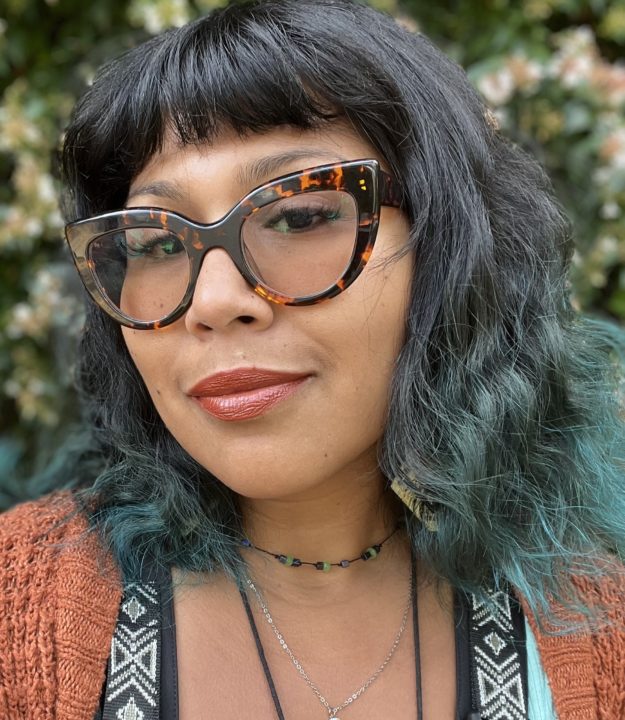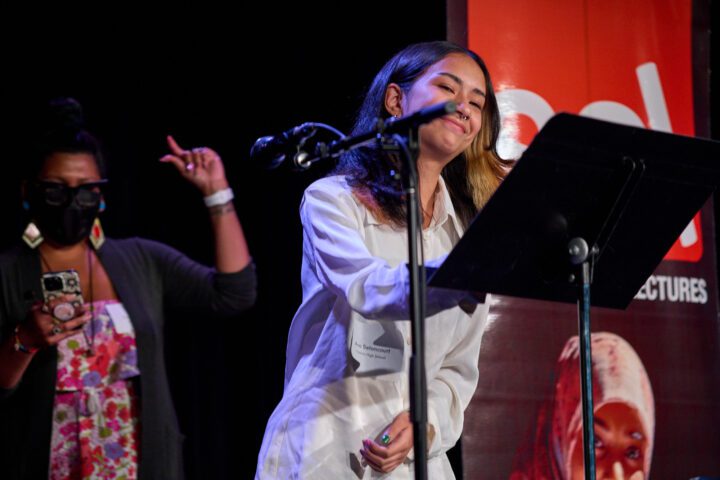
A Conversation with Clara Olivo, WITS Writer-in-Residence
September 5, 2023
This month, we’re sharing stories woven with heart and light from our Youth Programs community. Today, WITS Writer-in-Residence Clara Olivo shares their teaching practice, how they inspire and impart wisdom on youth, and what artists need to thrive in Seattle.
Tell us about yourself as a writer. What are you writing and working on?
That’s a big question, especially right now in my life! I’m in the process of working on my second book right now. I’m building my manuscript, which is a collection of poems and essays, reflecting life on the margins and on the spectrum. It’s something I started working on two or three years ago, when I started my first book—I didn’t realize that I was writing another book while I was writing my first one. I’ve spent this whole year attending residencies and workshops, really trying to hone my craft and understand the craft of writing itself.
How does your poetry inform your teaching practice, and vice versa?
I didn’t go to school to be a writer. Unlike many of my peers, I do not have an MFA. I went to culinary school, I dropped out of high school, so I have a very different education background than a lot of writers, and I think that’s one of the things I bring with me into the classroom. During my time at [Franklin High School], the students that I connected with most are students who, in so many ways, reminded me of me at that age. I saw in them that desire to want to do and be more. Seeing my students up [on stage at the WITS Year End Readings] was such a powerful moment for me, because at that age, I didn’t have any of that. Where I am now, I can see the importance and the value in using poetry as a vessel for change pouring into the younger generation. Once I’m gone, I’m gone, but whatever I leave behind is going to continue to grow with them in some way, shape, or form. Even if it’s just, “Oh, I know what an acrostic poem is because someone 20 years ago told me about it!” I know that it makes an impact.
This was your first year teaching with WITS! What was that like?
Oh my god, WITS was so much fun! I taught one 11th grade class at Franklin for 14 weeks, and getting to connect with those students was very special. It was a Latin American literature class, so that specificity allowed me to create a curriculum that students could not only connect with, but something they could resonate with, too. Right off the bat, I was welcomed in and trusted as the person who is holding space for students to think about intersectionality in the diaspora. That was very special, because they’re thinking, “Who is this random person?” There has to be a lot of trust, and to hear that they enjoyed my facilitation and my expertise shows how powerful this work is.
How was it to engage with students on the first day, perhaps a bit shy or less engaged, and witness their transformation over 14 weeks?
It was pretty stellar. I went in with my own expectations, ideas, and insecurities. I thought, “Oh, they’re going to hate me, they’re going to think I’m boring. I’m not the cool teacher!” But then the students told me that I am the cool teacher! [Laughs] The classroom teachers have the advantage and the privilege of being with these students every day. I don’t have that, so when I’m there, I’m there to inspire and impart knowledge and wisdom. I’m going to do that in a way that’s not going to shame or humiliate the student or make them feel small. I want them to feel seen and to know that our time together is special. There were a few students who would always sit in the way back, and others expected that they wouldn’t do anything. Even those students said, “I’m not going to write anything, I didn’t write anything.” But that wasn’t true! I had their poems in my folder—they did the work, they are doing it, and so beautifully. It’s just inspiring, that hope, especially because that age, that time of life is just so hard! I remember that age very clearly, because it was a prominent time in my own life. On our last day, we put on a poetry reading and film festival. The students either created a video poem to screen, or they came up and read their poems. One student didn’t do either, but he still came up, and I said, “I got you. Here’s the poems that you wrote in the last weeks. Pick one to read. You already wrote them, and you did it to the best of your abilities. I’m so proud of you.” This is what it’s about—just inspiring and imparting that confidence. It was really beautiful to witness throughout.
Can you share a little bit about how you prepared for a lesson?
Knowing who I’m working with is the first thing. I want to meet people where they are and understand the demographics and the intention of the class. I made it a point to introduce writers that touched on some intersectional aspects of the group. Because this was a Latin American literature class, I wanted to focus mostly on Latin American writers and expanded that into the Latin American and Black diaspora because of the intersections the students and I hold. I wanted a lesson that represents the students I’m working with, to not only connect to themselves, but also to the greater history and landscape where we are. For example, I taught Claudia Castro Luna, who was the Seattle Civic Poet for a while. She’s from El Salvador and the author of several amazing books. I was very, very specific about wanting to show Central American women writers, or Black queer writers, because that representation isn’t prominent within the institutions [where] we teach.
I also wanted to make the lessons accessible and digestible. When you only have an hour or less with a group of kids, it’s important to keep things moving, so I’m intentional about the pace and transitions because I want to maximize my time. I’m always thinking, How are they going to walk into the class? What’s the first thing that they’re going to do or see? How do I get them mentally prepared to do X, Y, and Z, and what happens if we can’t do it? What are we going to do then, because things happen, and we need to pivot. I’m down to pivot, I love to dance, we have to do that.

What can students take with them into their lives, after having gone through WITS?
I want them to leave inspired and hopeful. I want them to recognize that they have power, more power than they give themselves credit for. And I want them to recognize that it’s already within them to bring the transformation they hope to see in themselves and the world around them. Poetry has a very beautiful way of tapping into that, even if it’s just to scratch the surface. [A WITS student] and I were having a conversation. She told me how she’s working through her own trauma right now, and I asked her, “Have you ever written a letter to your younger self and offered the love, support, and words she needs to hear?” Even something like that, you’re just planting that seed so they can let it bloom. Even if it’s starting small with a conversation or a love letter to themselves, it’s well within their power to bring that healing and joy. It’s very easy to have that joy ripped away from you, especially when the world is constantly telling you that you’re not worthy, so I want them to know that they’re worthy.
How can writers and artists be supported and thrive in a city like Seattle, to continue inspiring the next generation and making room for their own creative practice?
Seattle is one of the most expensive cities in the world, period. Even those with privilege really struggle in this city. As an artist, I need time, I need space, I need connection and community, and SAL is learning to incorporate that into our framework with WITS in new ways. As a whole country, it’s a new thing to actually think collectively, rather than independently. What does it look like to lean into that collective mindset and think about the ways that the power and privileges we hold can better sustain our communities? If it’s not donating money, then what does donating time or donating resources to artists look like? I’m thinking about the Rockland residency that WITS writers are going to in September. That’s a great opportunity to support writers right there, opportunities where we can come together, whether it’s to create together or to just exist together and build relationships to learn from one another. And to be able to do that safely, without the stress of, “Oh my god, I have to pay my bills” or “I have to be at this and that.” What does it look like to sustain and support our writers, so that they can live fully as writers and artists, and tap into the work without being overwhelmed? It just boils down again to the time, the space, the resources, the access.
How does Youth Programs and SAL, more generally, invest in the creative life of the Puget Sound Region?
Any opportunity to work with young people is doing exactly that—being able to work with young people and offer a different perspective or a different approach. And not just in academia, right? Yes, we’re in schools, we have a curriculum, we have an agenda, et cetera. But there’s so much more that we can do with that, and it boils down to the relationship between the writer and the students. It’s the connection and the resonance that I was talking about earlier. Anybody can go into a classroom and teach a curriculum, but not anybody can come into the classroom and develop relationships where young people actually feel seen and heard—that’s such a transformative shift in and of itself. Especially right now, when we’re seeing all of these book bans and changes in the education system. We’re doing some revolutionary work right now, and the students see that. Again, poetry has the power of shifting mindsets, and WITS and SAL are giving the platform to students to share their voice and truth in a way they hadn’t before. [The WITS Year-End Readings] were my students’ first readings. For them to be so young, and to have a literal platform to stand and speak their words so powerfully, it echoes into the rest of the world and the rest of the timeline. I know there’s at least one person in that audience that’s going to take those words and create something more effective. We’re just scratching the surface, the students are the ones who are doing the work.
Thank you, Clara!
This interview has been edited for length and clarity.